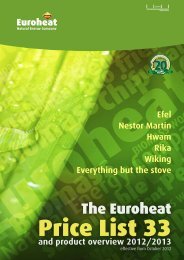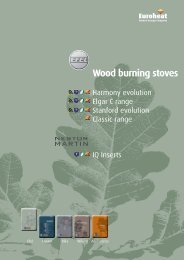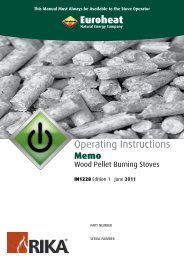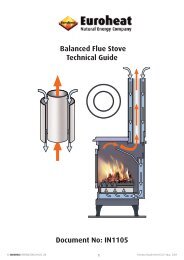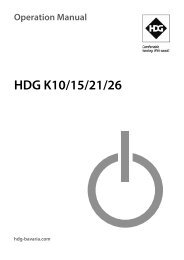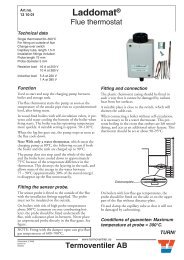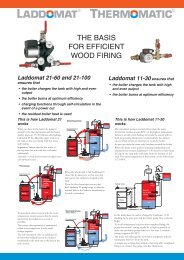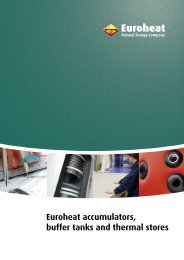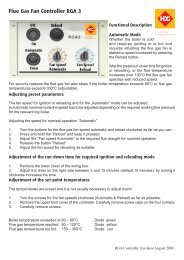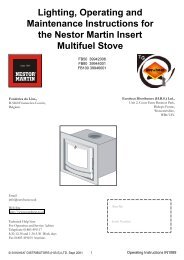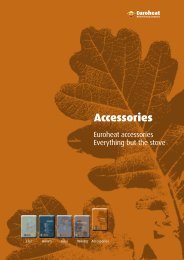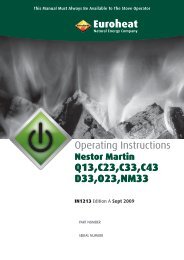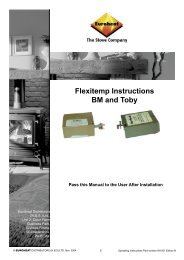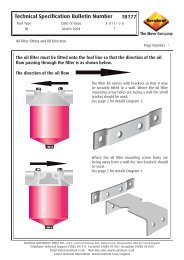IT13 Operation - Euroheat
IT13 Operation - Euroheat
IT13 Operation - Euroheat
You also want an ePaper? Increase the reach of your titles
YUMPU automatically turns print PDFs into web optimized ePapers that Google loves.
Advanced Driving With Wood<br />
Once the insert is at its operating temperature it is capable of burning cleanly<br />
and efficiently with little or no intervention from you beyond periodic loading<br />
of wood.<br />
Two reasons for a insert failing to operate cleanly and efficiently make all other<br />
reasons virtually insignificant. One is the use of wet wood, which should never<br />
be used, and the other, which we will be discussing now, is the inappropriate<br />
intervention by an operator failing to understand a few simple principles.<br />
When to Put on More Wood<br />
When the fire in the insert has become established you will find that the insert seems, initially, to consume wood<br />
quite quickly. This is because the insert was designed to burn off the wood’s volatile matter first, leaving the<br />
charcoal to form a hot bed above the grate. The charcoal helps maintain a constant heat output from the insert<br />
between loading of wood and aids the rapid ignition of new loading, thus minimizing smoke emissions. The<br />
depth to which the charcoal should be let to accumulate will depend upon the length of time you are expecting<br />
to operate the insert for and the heat output you need. Never load more wood than can be contained safely by<br />
the log guard.<br />
Putting new wood on immediately the flames of the previous loading have almost extinguished will result in a<br />
very hot insert with a deep charcoal bed capable of being controlled to burn very slowly, without staining the<br />
glass, for many hours. If only a low heat output or limited burning time is required the charcoal will be producing<br />
much of the heat with an occasional log being loaded for interest. Letting the bed become too small, or putting<br />
on a new log when all the flames from a previous loading have extinguished will cause smoke as the new loading<br />
struggles to ignite. Always add wood to the insert before flames from a previous loading have extinguished. If<br />
there are no flames, only glowing embers, add a small amount of kindling wood and set the insert to its ignition<br />
setting. Never put logs onto a fire without flames, they will smoulder and emit smoke.<br />
X<br />
How to Put on More Wood<br />
Wood needs not only heat but also air to burn and putting an enormous amount of logs at one time or interlocking<br />
them like bricks will both stifle the existing fire, causing it to cool; it will also limit the air available for the new<br />
wood. This will result in delayed ignition of the loading and unacceptable levels of smoke emission.<br />
Always try to keep ends of logs away from the combustion chamber walls so that gasses emanating will have<br />
good access to air. If you are having to burn unsplit logs, they will release most of their initial gasses only from<br />
their ends, it is important to rake embers so that the log ends are over the charcoal bed to heat the gasses to<br />
promote rapid ignition. Avoid burning un-split logs if you can. If the logs are split it is better to put the log on the<br />
fire bark side down because the bark will ignite rapidly when placed on the charcoal and gasses from the split<br />
surfaces will have an unrestricted air supply.<br />
© EUROHEAT DISTRIBUTORS (H.B.S) LTD. June. 2010 19<br />
Instructions Part Number IN1180 Ed.D1<br />
X



